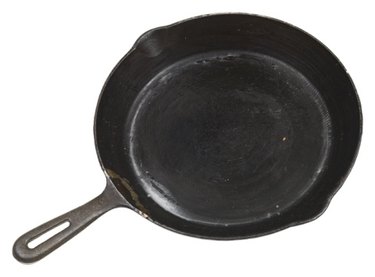Things You'll Need
Liquid dishwashing soap
Dish cloth
Absorbent towel
Aluminum foil
Solid vegetable shortening or cooking oil
Timer
Stiff nylon scrub brush or a plastic scraper (optional)
Paper towel (optional)

Cast-iron cookware is heavy, durable and lasts for many decades with the proper care. Some cast-iron skillets come pre-seasoned and only require rinsing with hot water and a thorough drying before using. Others need to be seasoned first to ensure foods don't stick to the surface. If your skillet has become rusty, turned dull gray or has food stuck to it, it will require re-seasoning. The methods are the same for new or old cast-iron cookware.
Step 1
Wash the cast-iron skillet with warm, soapy water and a dish cloth. Rinse well and dry with an absorbent towel.
Video of the Day
Step 2
Place a sheet of aluminum foil on the bottom rack of your oven to catch any oil drips while seasoning.
Step 3
Coat the interior and exterior of your skillet with a thin layer of solid vegetable shortening. You may use cooking oil if you prefer.
Step 4
Set the oven to 350 degrees Fahrenheit.
Step 5
Lay the cast-iron skillet upside down on the top rack of your oven and shut the oven door.
Step 6
Set a timer for an hour, then turn the oven off. Leave the skillet inside until it sufficiently cools. The skillet is ready to prepare foods.
Tip
Don't use soapy water to clean your cast-iron skillet. Hot water and a stiff nylon brush or plastic scraper are all you need to clean the skillet after each use. Dry it thoroughly with an absorbent towel to prevent rust spots.
Foods that are moist and acidic, such as spaghetti sauce or applesauce, absorb more iron than other foods when prepared in cast-iron cookware. Foods that require a longer cooking time absorb more iron content than those that require shorter preparation times.
If your skillet has a lid, store the skillet with a folded paper towel separating the lid and skillet to circulate air and prevent rusting.
Video of the Day